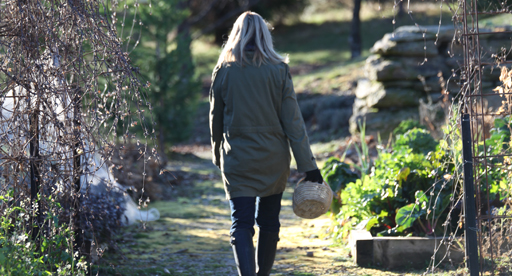
For a few weeks now I have been covering the tomato, pepper and zucchini plants with frost cloth each night in a hopeful effort to keep things ripening. But despite all my attempts to swing nature my way, the days are getting too short and it’s just too cold. Finally I have to accept it – the growing season has come to an end. It’s time to start putting the garden to bed for the winter.
Annabel Langbein’s Thai Pumpkin Soup

The most time-consuming part of this recipe is cutting up the pumpkin. Microwaving a whole pumpkin for 10 minutes makes cutting easier. Store the soup in the fridge for up to 4 days or freeze in small pottles.
- Prep time: 10 mins
- Cook time: 30 minutes
- Serves: 4
Ingredients
- 2 tbsp olive oil
- 1 onion, finely chopped
- 1 tbsp brown sugar
- 2 cloves garlic, crushed
- 1 medium (about 1.2kg) pumpkin, such as buttercup, peeled and diced
- 2 cups water
- 400ml can coconut milk
- 1-2 fresh, dried or frozen chillies, finely chopped
- finely grated zest of 2 limes or 1 tbsp lemongrass, finely chopped
- 1 tbsp fish sauce
- salt and ground black pepper
- 1/4 cup fresh coriander or parsley, chopped
- Coconut Sambal, to garnish (optional)
Method
- Heat oil in a big pot and gently cook onion, sugar and garlic until onion is softened (8-10 minutes).
- Add all other ingredients except fresh coriander and simmer until tender (about 20 minutes).
- Mash roughly, adjust seasonings to taste and stir through coriander.
Alternatively, finish with a scoop of Coconut Sambal (as pictured). For this recipe see my website
I have been leaving all my soup beans to dry on the plants, and now the husks are dry I know the beans are ready to store. I just strip the beans off as I pull the plants out and put them, variety by variety, into jars for the pantry. It’s so satisfying and they look so pretty, especially the mottled pink berlotti beans. If you are worried your beans aren’t dry enough you can leave them on a rack in the shed for a few weeks – when the husks feel crispy they are ready to strip and store. I also save some to plant again next year.
I find my homegrown dried beans cook up much fatter and are ready much more quickly than the store-bought ones. Certainly when it comes to cooking dried beans there can be huge variations in time – I guess when you buy them they could have been around for years.
If you still have loads of unripe tomatoes you can try pulling the whole plant out by the roots and hanging it upside down in a warm, sunny place out of the cold. As long as where you have them hanging is warm enough, there is enough energy in the plant to keep the tomato fruit ripening for another few weeks.
Before you start pulling everything out of the garden, remember it’s really only the frost-tender plant families that need to come out – that means all the nightshade family and the cucurbits. The potatoes, belonging as they do to the nightshade family, will die back on the tops, but they can stay in the ground for another few weeks. I always cover my potatoes, including any that are still green topped, with a thick layer of pea straw – this helps protect the tubers and stops the soil from freezing for a little while longer. But don’t leave them too long – if you let the potatoes freeze they won’t keep.
Most of the other plant families are more tolerant of the cold. Beets, carrots, leeks, parsnips, turnips, brassicas and radishes will keep going through the winter. It’s a good idea to give crops that are staying in the ground a feed with some Seasol, as this helps protect them against the frost. Mulching around them with some good compost also keeps the soil warm and provides them with useful nutrients.
At this time of year, one of the key things to work on is eliminating any potential overwintering sites for insects and disease. Bugs love old piles of weeds, so you need to get these out of the garden. Prune and cut back, and remove all the prunings and pull-outs from the garden – as long as they are disease free they can go in the compost or the worm farm. Otherwise, get them off the property or burn them, as the spores in many diseased plants, especially blight, will come back and plague you next season. Pull out the weeds and gently till the soil to expose any insects who plan to overwinter.
Once most of the garden soil is exposed, add a layer of compost, manure (if you have it) and lime (if you need it). Gently work this into the soil. Over the winter it will all break down, and come spring you will have your bed ready for planting without having to do any work. I always like to rest one or two garden beds each year – planting with cover crops, such as mustard, improves the soil and reduces weeds. I have real trouble with wireworm in Wanaka (apparently this is common when you create a garden out of a paddock) and I have found that planting mustard for a season really helps to keep it at bay – the worms hate the smell that the mustard produces in the soil.
I grow all my citrus in pots, as the plants won’t tolerate our southern frosts through the winter. It’s always a bit of an effort to get the heavy pots into the conservatory, but they won’t survive if I don’t, and in a couple of months’ time the fragrance of orange blossom will perfume the whole house. It’s truly one of the most wonderful scents of winter and early spring.
Herbs like sage, thyme, French tarragon, rosemary and chives are all perennials so will go dormant or die back over the winter and then come away again next spring. That said, chives are such a hardy plant you can repot them and bring them inside for harvests over the winter months. Dig up a clump, put into a pot and leave outside until the tops die right down. Then bring it inside into the warmth and in a few weeks you will have chives ready to harvest again!
It’s not too late for a few final winter plantings of brassicas, carrots, silverbeet, winter lettuce, rocket, miner’s lettuce and mache. Get these into the ground now and you will enjoy their harvests through late winter and early spring.
Pumpkins, garlic, onions and shallots should be safely out of the ground and in the store by now. It’s probably almost time to dip into the first pumpkin of the season – if you haven’t already – and whip up a batch of your favourite pumpkin soup. I love this spicy Thai version and it’s a recipe you can freeze as well.
Although best known as a cookbook author and publisher, Annabel Langbein is also a highly experienced and knowledgeable gardener. She studied horticulture at Lincoln University and for many years has grown her family’s fresh produce in her gardens and orchards in Wanaka and Auckland. Her seasonal harvests are the inspiration for many of the inventive but easy recipes in her books and TV series.
For more great Annabel Langbein recipes see annabel-langbein.com
Post a comment
Annabel Langbein's May Garden Comments
Have you got a simplier pumkin soup that would suit small children,as they do not like garlic or coconut?Many thanks
Peggy
Love your emails and all the lovely recipes, and your recipe book which is great.
Amanda Gower
After years of getting wireworm and fly in my carrots I sprinkled crushed mothballs with the seed. Not one infested carrot this crop!
Kev Gunn
excellent,must make it and try it,thank you
alistair aitken
Love this article - a real inspiration and love the handy tips. Filled me in with info I really needed. Going to try the great recipe for the Pumpkin soup - sounds divine. Well done Annabel and thanks!!!
Deb Beardsley
Hi Peggy, thank you for your comment. You can leave the garlic and coconut cream out but would need to replace the coconut cream with cream or stock. You are probably best to also leave out the lemongrass, chilli and fish sauce and just make a plain pumpkin soup, rather than a Thai one :) Thanks Jenna - Tui Team
jenna
Hi Kev thank you for your comment, that is a great tip to share to eliminate wireworm and fly from carrots. Thank you for sharing! Jenna - Tui Team
jenna